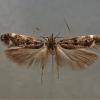35.088 Neofriseria singula (Staudinger, 1876)
Status and Distribution
Very local, occuring in south-east England and East Anglia.
Early records listed under N. suppeliella may refer to N. peliella. There is also potential for confusion over the identification of these two due to their external similarity (particularly with worn, non-bred specimens) and that the genitalia are similar.
During 2015 searches were made for the larva of N. singula at Dungeness, Kent as several records had been submitted in the past but required confirmation - the only larvae found (and there were very many) were N. peliella. Later in the season, extensive checks of over 50 Neofriseria sp. attracted to MV light (S. P. Clancy and S. M. Palmer) between late June and late July produced only N. peliella. Further examination of Museum specimens is now required to see if any historic N. singula can be verified from this site.
Provisional map
Foodplant and Larval Feeding Signs
Rumex acetosella (sheep's sorrel), see plant distribution map.
Feeds from a silken tube at the base of the stem (larva dull green with black head).
Habitat
Found mainly on inland heathland and breckland.
Finding the Moth
Larva: feeds from a silken tube at the base of the stem - sometimes associated with plants on anthills.
Adult: can be swept, occasionally flies during the day and comes to light.
Similar Species
Neofriseria peliella and N. singula are very similar with just enough variation in the wing markings to allow identification of only reasonably fresh specimens. The genitalia are also quite similar and the best way to separate the two is by the colour of the larva (see below).
In fresh, well-marked specimens N. peliella has the lower of the two black spots at two-fifths on the forewing usually slightly basad (nearer the wing base) of the upper. The forewing colour is blackish fuscous with the base of the scales slightly greyish giving a slightly mottled appearance. In N. singula the spots at two-fifths are directly one above the other and the forewing colour is greyish fuscous with a variable ammount of dusting of dull yellowish-white scales. N. singula is slightly smaller on average (13-15mm wingspan) than N. peliella (13-16mm) but there is considerable overlap.
Genitalia differences are only discernable in the males, with that of N. peliella being broader in the uncus, having a stouter harpe and a more evenly tapering tip to the aedeagus.
The larvae are distinctive with the body of N. peliella being chocolate-brown (see further comments under that species) and that of N. singula pale dull green; both have black heads and prothoracic plates.
Studies at a locality in Denmark, where both species occur at the same site, have supported the specific distinctness as each is attracted to a different pheromone.
Single brooded during June and July.
Earliest: 3rd June 1848 (VC17)
Latest: 12th August 2011 (VC27)

